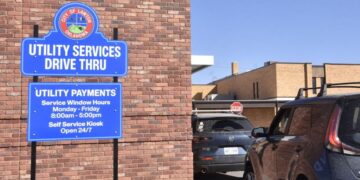A new facility for Lawton animal shelter was the only idea outlined Tuesday when the City Council solicited residential comments about ideas for unspent funds in the 2019 Capital Improvements Program.
While two residents made pitches for funds that City of Lawton finance officials calculate will be coming into the CIP, City Council members said they’ve heard other proposals from constituents, including increased spending for streets and better maintenance of city facilities.
Mayor Stan Booker was careful to say the funds are not surplus or excess. Neither term is correct, he said, adding the money is inflationary unspent funds that result from the difference between the $23.5 million that city staff estimated would be generated by the CIP sales tax in the 2022-2023 fiscal year, and the $28,972,607 that city officials actually expect. Booker said the funds are being affected by inflation, just as project costs are. He said when costs for projects included in the CIP were calculated in 2019, inflation was only 2 percent. It is significantly higher now, Booker said, and not only are sales tax receipts higher, so are construction costs.
“It is not surplus or excess,” he said, adding all funds generated by the CIP’s sales tax will be allocated to funding categories created within the resolution guiding the tax and expenditures.
That same resolution also specifies the council must solicit input from residents at two public meetings, on the usage of funds. The provision states that if revenues exceed $23.5 million annually, “such funds will be considered excess funds and those excess funds will be allocated by the Council upon receipt of input from citizens at no less than two open meetings of the Council.”
Two women had specific ideas for those funds: a new facility at the city animal shelter that would allow a greater amount of pets to be adopted, rather than euthanized.
One woman said while the idea originally crafted in 2015 was to build an adoption center separate from the animal shelter, it would make more sense to build a completely new and larger facility to address both adoptable animals and strays. She said such a facility would fit under a defined category in the CIP resolution for city facilities.
Marcia Cronk, who is involved with the group Comanche County Pet Resource Foundation, said the local problem is multi-layered. She said while there is a problem in the community with loose animals (some attacking people and other pets), the city animal shelter also has insufficient staff to meet its needs and staff members who may be suffering from burnout and depression. Cronk said Lawton needs a multi-pronged approach to animal-related issues, such as community education and resources for families in need so they can “keep their pets at home and out of shelters.” At previous meetings, Cronk said the group is working to establish a facility to address those needs.
Several council members said constituents have told them a primary concern in the community is streets: the city needs to focus more resources on upgrading them. But, Ward 2 Councilman Kelly Harris said while the City of Lawton does have a plan to address roads, city officials must be careful of spending what he and others call one-time funds (meaning, CIP revenues aren’t permanent funds).
Ward 3 Councilwoman Linda Chapman said her constituents are concerned about upkeep of city facilities, adding that the city’s tendency over the years is not taking are of the facilities it has. She specifically mentioned roof work to control leaks at Museum of the Great Plains, and multiple needs at city recreation centers.
“We need to figure out a way to fund them,” she said, of what she called quality of life issues city officials have said are important.
City staff also has a suggestion for those surplus funds: addressing higher-than-projected costs for the Lawton City Hall renovation project. The 2019 CIP allocated $6 million for renovations that will turn three unused floors in the building to city use and fund upgrades on floors already being used, as well as upgrade the HVAC system in the building. Recent cost estimates based on subcontractor bids total $7.5 million.
Want to reach a local audience and grow your business?
Our website is the perfect platform to connect with engaged readers in your local area.
Whether you're looking for banner ads, sponsored content, or custom promotions, we can tailor a package to meet your needs.
Contact us today to learn more about advertising opportunities!
CONTACT US NOW





